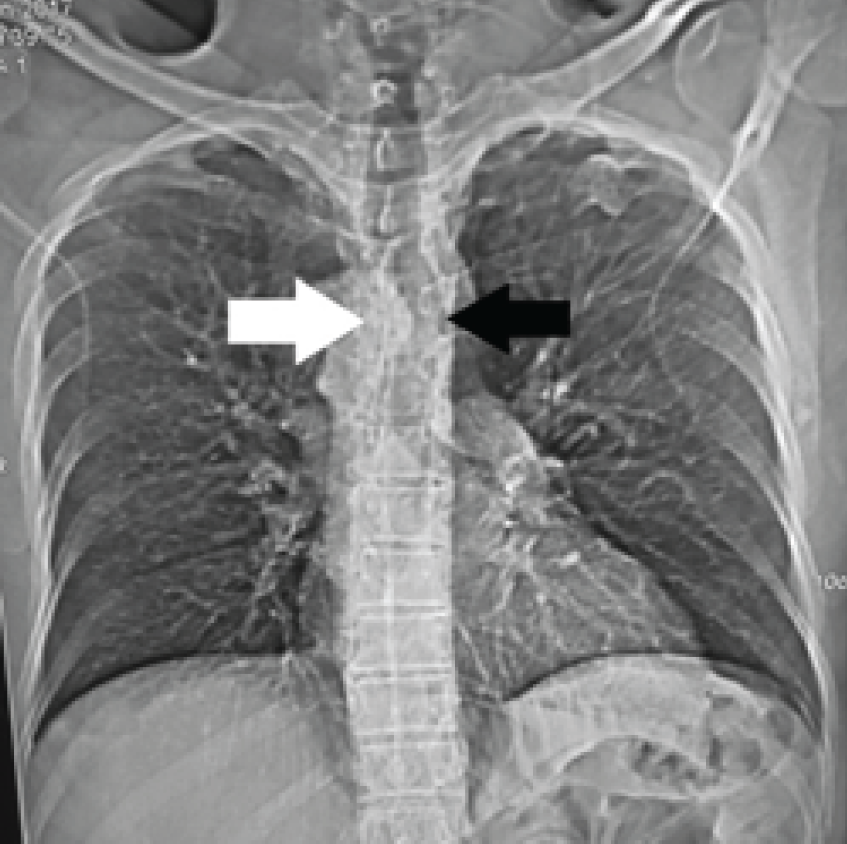Background
Right sided aortic arch with aberrant left subclavian artery (ALSA) is seen in 0.05% of the general population. The incidence of isolated right aortic arch is approximate 0.1% [1]. Originally, only aberrant right subclavian having slight dilatation at the origin was called as Kommerell diverticulum. This was named after Burckhardt Kommerell in 1936. Now the dilatation of aberrant subclavian at the origin is also called by the same name [2].
Case presentation
60-years old male reported to otolaryngology department with complaints of mild headache with vague chest pain and neck pain of two weeks duration. On examination, the patient was of averagely built without any previous history of illness or any systemic disease. Systemic examination was unremarkable. X-ray paranasal sinus was unremarkable. Plain X-ray chest had shown right sided aortic arch without any other abnormality (Figure 1).
All the basic blood investigations were within normal parameters. The patient underwent contrast-enhanced computerized tomography (CECT) with 16- slices Siemens Scope whole body CT scanner. The findings revealed right sided aortic arch with aberrant left subclavian artery (ALSA). There was no abnormality in both the lung fields and mediastinal anatomy was within normal limits. Aortic arch was seen encircling the trachea (Figure 2).
The course of the thoracic aorta comes to the midline or to the left side as it approaches the diaphragmatic aperture (Figure 3). Common carotids on both sides could be seen originating from the arch independently

Plain X-ray chest PA view. The aortic knuckle is seen on right side (white arrow) and there is tracheal indentation over trachea at the same level (black arrow). Rest of the mediastinal structures are at normal sites.

CECT Thorax axial section at aortic arch level. Aortic arch is seen on right side (white arrow) with trachea on left side (hollow white arrow).
almost in midline position (hollow white arrow). (Figure 4) Left subclavian had taken origin from the right side and coursing towards the left side lying posterior to the esophagus (Figure 5).
The patient was placed on symptomatic treatment as no further management was warranted in this case.
Discussion
Isolated right sided aortic arch is comparatively a common vascular anomaly and in many times this can be visualized as an incidental finding in CECT chest. This develops because of the regression of the portion of the dorsal segment between the left subclavian and common carotid in the hypothetical double arch. There is also persistence of the fourth embryonic aortic arch on right side [3]. Sometimes this becomes symptomatic because of the vascular rings and due to other additional abnormal findings [4]. Following two types of entities are of clinical importance:
Type I: Mirror image
Type II: when present with aberrant left subclavian artery (ALSA)Our present case falls in Type II category. Type I is associated with other congenital anomalies. Type II is very rarely associated with congenital heart disease (CHD) as compared to Type I. The most common association with Type I is Tetrology of Fallot. ALSA can be retro-tracheal or retro-esophageal and may become symptomatic sometimes [5]. In our case, it was retro-esophageal and was asymptomatic. The order of origin of the vessels is left common carotid, right common carotid, right subclavian and then ALSA. This entity is slightly less common than the aberrant right side subclavian artery from the left side aortic arch. MDCT is the modality of choice for the delineation of these anomalies. Magnetic resonance imaging (MRI) and barium swallow play the additional role in the diagnosis of the vascular rings [6]. Dysphagia lusoria and dyspnea are the common complaints felt because of vascular rings. Magnetic Resonance Angiography (MRA) and Computerized Tomography Angiography (CTA) confirm the vascular mapping of the anomalies in detail.




